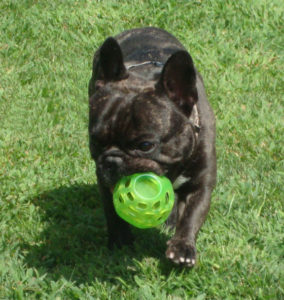Your dog loves you. He’s a genius at picking up your cues. Sometimes you even wonder how he knows what you want before you say it. Despite that – your dog isn’t a mind reader. If you’re not clear, your dog won’t be, either.
In our obedience classes, we often have to tell our students to “get loud!” Or “don’t ask your dog, tell her!” It’s not that anyone has to be rude, yell, or be mean to their dogs. But we do have to be clear.
The one example that everyone seems to understand is a parent telling a child to take out the trash (or do any chore). The first time Mom asks: “Bobby, will you please take out the trash?”
The second contact is a bit more emphatic: “Susie, I asked you to take out the trash. Do it now, please.”
The third time, Mom just wants it done. “Sam, take out the trash. NOW.”
Third time is usually the charm – when Mom is using “Mom voice.” That’s what we call it and everyone understands the concept.
We tell our students to use “Mom voice” for their dogs. It doesn’t have to be loud. But it does have to be in the form of a statement, not a question. When we’re playing training games with our dogs, we don’t want them to have questions, so we have to be clear.
If you want your dog to sit, say “Dog, Sit!” Click when the dog’s butt quickly hits the floor and reward promptly. If Dog sniffs, stands there looking at you, looks around, or takes a few steps and eventually sits – that’s not sit. That’s “ignore what I say until it suits your convenience.” Don’t reward that rude behavior!
The relationship between you and your dog is not only a loving one – it’s also one that should embody respect on both sides. You respect your dog and want to help him have the best, happiest life possible in this weird, human world. Your dog should respect you as the leader of your team.
We don’t expect our dogs to be “on duty” all the time. They are expected to obey the rules of the house like any family member: don’t pee anywhere but where you’re supposed to, get up when the alarm goes off, no fighting, no biting. Other than that, they’re like any dogs – they hang out on the furniture, chew on toys or bones, wrestle and chase each other around.
And it’s training that lets them know what is, and is not, acceptable behavior.

Torque, Hope’s French Bulldog, is crazy about certain toys. He tends to forget his manners when he plays with them. So he’s only allowed to play with them with Hope, in a controlled environment. And she’s absolutely clear when playing with him. If she says “drop,” it means she’s going to throw the toy and he’ll be able to play some more. If she says “that’s all,” it means toy time is over and he’ll get a reward for giving it up.
She uses two different phrases so Torque knows what’s going to happen. Hope is clear in what she’s asking, so Torque knows the behavior that will get rewarded.
That’s the deal we make with our dogs. They get what they want when we get what we want. It’s still a great bargain.
